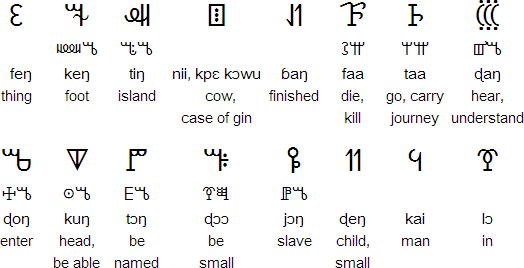Vai syllabary 
The Vai syllabary was invented in about 1820 in Liberia by Momolu
Duwalu Bukele, who was inspired by a dream to create a writing system
for the Vai language. In 1854 a German philologist, S. W. Koelle,
met Duwalu Bukele while researching the Vai langauge and was told
that in Bukele’s dream a tall, venerable-looking white man in a
long coat appeared and said “I am sent to you by other white men …
I bring you a book.” Bukele was then shown many signs, but couldn’t
remeber them when he woke up, so he made new signs with some friends.
Another theory about the origins of the Vai syllabary is that it
developed from ancient pictographs, and that Bukele possibly
phoneticized those symbols.
The syllabary proved popular with the Vai and by the end of the 19th
century most of them were using it. In 1962 the Standardization Committee
at the University of Liberia standardized the syllabary. A Vai version
of the New Testament in the Vai script appeared in 2003.
Notable features
- Type of writing system: syllabary
- Direction of writing: left to right in horizontal lines
- Each symbol represents a consonant plus a vowel
Used to write
Vai (ꕙꔤ), a member of Mande group of
Niger-Congo languages spoken by about 104,000 people in Liberia, and
by about 15,500 people in Sierra Leone.
Vai Syllabary

Historic syllables
These are syllables that uesd tobe written with different symbols.
The symbols used today are show below them.

Vai logograms

Vai punctuation
![]()
Vai numerals

Download the Excel speadsheet used to make these charts
Sources: http://scripts.sil.org/cms/scripts/page.php?&item_id=VaiUnicode
and http://en.wikipedia.org/wiki/Vai_language
Sample text

Transliteration
Adhama deng nu gbi tong manja deng nu wa anuan wooloo kiiye fe,
amu bee sii londoe wa be anuan koowa. anda koo temaan lo ka so amu
anu fala be. Koomu anuhin koo nu tahaye lei la kemu nehin nyoon la
kung tiya anu te.
Translation
All human beings are born free and equal in dignity and rights. They are endowed with
reason and conscience and should act towards one another in a spirit of brotherhood.
(Article 1 of the Universal Declaration of Human Rights)
Links
Information about the Vai language and syllabary
http://en.wikipedia.org/wiki/Vai_language
http://en.wikipedia.org/wiki/Vai_syllabary
Official Vai unicode chart (PDF)
http://unicode.org/charts/PDF/UA500.pdf
Free Vai fonts
http://scripts.sil.org/cms/scripts/page.php?site_id=nrsi&item_id=SILVai
